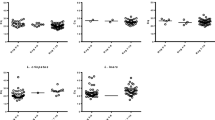Abstract
Purpose
To evaluate a real-time PCR-based technique to quantify bacteria associated with aerobic vaginitis (AV) as a potential test.
Methods
Vaginal samples from 100 women were tested by wet-mount microscopy, gram stain and quantitative real-time PCR targeting Enterobacteriacea, Staphylococcus spp., Streptococcus spp., Enterococcus spp., Escherichia coli, Streptococcus agalactiae, S. aureus; Lactobacillus spp. AV diagnosis obtained by wet-mount microscopy was used as reference.
Results
Some level of AV was diagnosed in 23 (23.7 %) cases. Various concentrations of Enterobacteriacea, Staphylococcus spp., Streptococcus spp. were detected an all patients. Enterococcus spp. were detected in 76 (78.3 %) cases. Summarized concentrations of aerobes were tenfold higher in AV-positive compared to AV-negative cases [7.30lg vs 6.06lg (p = 0.02)]. Concentrations of aerobes in severe, moderate and light AV cases did not vary significantly (p = 0.14). Concentration of lactobacilli was 1000-fold lower in AV-positive cases compared to normal cases (5.3lg vs 8.3lg, p < 0.0001). Streptococcus spp. dominated in the majority of AV-positive cases [19/22 (86.4 %) samples]. The relation of high loads of aerobes to the low numbers of Lactobacilli are a reliable marker for the presence of AV and could substitute microscopy as a test.
Conclusions
PCR may be a good standardized substitution for AV diagnosis in settings where well-trained microscopists are lacking.




Similar content being viewed by others
Notes
Logarithm to the base ten.
References
Donders GGG, Bellen G, Rezeberga D (2011) Aerobic vaginitis in pregnancy. BJOG 118(10):1163–1170. doi:10.1111/j.1471-0528.2011.03020.x
Donders GGG, Vereecken A, Bosmans E, Dekeersmaecker A, Salembier G, Spitz B (2002) Definition of a type of abnormal vaginal flora that is distinct from bacterial vaginosis: aerobic vaginitis. BJOG 109(1):34–43
Donders GGG, Van Calsteren K, Bellen G, Reybrouck R, Van den Bosch T, Riphagen I et al (2009) Predictive value for preterm birth of abnormal vaginal flora, bacterial vaginosis and aerobic vaginitis during the first trimester of pregnancy. BJOG 116(10):1315–1324. doi:10.1111/j.1471-0528.2009.02237.x
Zodzika J, Rezeberga D, Jermakova I, Vasina O, Vedmedovska N, Donders G (2011) Factors related to elevated vaginal pH in the first trimester of pregnancy. Acta Obstet Gynecol Scand 90(1):41–46. doi:10.1111/j.1600-0412.2010.01011.x
Fan A, Yue Y, Geng N, Zhang H, Wang Y, Xue F (2013) Aerobic vaginitis and mixed infections: comparison of clinical and laboratory findings. Arch Gynecol Obstet 287(2):329–335. doi:10.1007/s00404-012-2571-4
Bologno R, Díaz YM, Giraudo MC, Fernández R, Menéndez V, Brizuela JC, Gallardo AA, Alvarez LA, Estevao Belchior SG (2011) Importance of studying the balance of vaginal content (BAVACO) in the preventive control of sex workers [Article in Spanish] Rev Argent Microbiol. 43(4):246–50. doi: 10.1590/S0325-75412011000400002.[
Marconi C, Donders GG, Bellen G, Brown DR, Parada CM, Silva MG (2013) Sialidase activity in aerobic vaginitis is equal to levels during bacterial vaginosis. Eur J Obstet Gynecol Reprod Biol 167(2):205–209. doi:10.1016/j.ejogrb.2012.12.003
Tansarli GS, Kostaras EK, Athanasiou S, Falagas ME (2013) Prevalence and treatment of aerobic vaginitis among non-pregnant women: evaluation of the evidence for an underestimated clinical entity. Eur J Clin Microbiol Infect Dis 32(8):977–984. doi:10.1007/s10096-013-1846-4
Donders GGG, Vereecken A, Van Bulck B, Cornelis A, Dekeersmaeker A, Klerckx P et al (2008) The ecology of the vaginal flora at first prenatal visit is associated with preterm delivery and low birth weight. Open Inf Dis J 2:45–51. doi:10.2174/1874279300802010045
Rezeberga D, Lazdane G, Kroica J, Sokolova L, Donders GG (2008) Placental histological inflammation and reproductive tract infections in a low risk pregnant population in Latvia. Acta Obstet Gynecol Scand 87(3):360–365. doi:10.1080/00016340801936487
McDonald HM, O’Loughlin JA, Jolley P, Vigneswaran R, McDonald PJ (1991) Vaginal infection and preterm labour. Br J Obstet Gynaecol 98:427–435
Donders GG, Riphagen I, van den Bosch T (2000) Abnormal vaginal flora, cervical length and preterm birth. Ultrasound Obstet Gynecol 16(5):496–497
Donati L, Di VA, Nucci M, Quagliozzi L, Spagnuolo T, Labianca A et al (2010) Vaginal microbial flora and outcome of pregnancy. Arch Gynecol Obstet 281:589–600
Carey JC, Klebanoff MA (2005) Is a change in the vaginal flora associated with an increased risk of preterm birth? Am J Obstet Gynecol 192:1341–1346
Zarbo G, Coco L, Leanza V, Genovese F, Leanza G, D’Agati A, Giannone TT, Giunta MR, Palumbo MA, Carbonaro A, Pafumi C (2013) Aerobic vaginitis during pregnancy. Res Obstet Gynecol 2(2):7–11
Cauci S, Hitti J, Noonan C, Agnew K, Quadrifoglio F, Hillier SL, Eschenbach DA (2002) Vaginal hydrolytic enzymes, immunoglobulin A against Gardnerella vaginalis toxin, and risk of early preterm birth among women in preterm labor with bacterial vaginosis or intermediate flora. Am J Obstet Gynecol 187(4):877–881
Cauci S, Culhane JF (2011) High sialidase levels increase preterm birth risk among women who are bacterial vaginosis-positive in early gestation. Am J Obstet Gynecol 204(142.e1):141–149. doi:10.1016/j.ajog.2010.08.061
Rumyantseva TA, Bellen G, Romanuk TN, Shipulina OIu, Guschin AE, Shipulin GA, Donders GG (2015) Utility of microscopic techniques and quantitative real-time polymerase chain reaction for the diagnosis of vaginal microflora alterations. J Low Genit Tract Dis 19(2):124–128. doi:10.1097/LGT.0000000000000060
Shipitsyna E, Zolotoverkhaya E, Agné-Stadling I, Krysanova A, Savicheva A, Sokolovsky E, Domeika M, Unemo M (2009) First evaluation of six nucleic acid amplification tests widely used in the diagnosis of Chlamydia trachomatis in Russia. J Eur Acad Dermatol Venereol 23(3):268–276. doi:10.1111/j.1468-3083.2008.03038.x
Author information
Authors and Affiliations
Corresponding author
Ethics declarations
Funding
This study was funded by Central Research Institute for Epidemiology, Moscow, Russia, and Femicare, Tienen, Belgium.
Conflict of interest
Authors declare that they have no conflict of interest.
Ethical approval
All procedures performed in studies involving human participants were in accordance with the ethical standards of the institutional research committee and with the 1964 Helsinki declaration.
Informed consent
Written informed consent was obtained from all individual participants included in the study.
Additional information
This work was an award winning presentation at the 1st ISIDOG/9th ESIDOG European conference in Riga, 29th Oct–1st Nov 2015.
Rights and permissions
About this article
Cite this article
Rumyantseva, T.A., Bellen, G., Savochkina, Y.A. et al. Diagnosis of aerobic vaginitis by quantitative real-time PCR. Arch Gynecol Obstet 294, 109–114 (2016). https://doi.org/10.1007/s00404-015-4007-4
Received:
Accepted:
Published:
Issue Date:
DOI: https://doi.org/10.1007/s00404-015-4007-4



